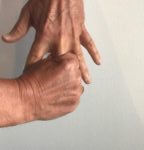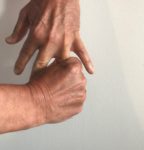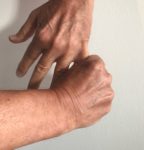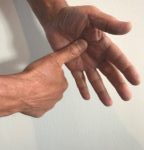By Kathryn Hayward, MD
Do you recall the moment when you first opened your eyes this morning? Do you remember how you felt? Do you know how much time elapsed between waking up and when you first looked at whatever device connects you to the internet? Do you recall how you felt five minutes later?
 Before you read further, cocoon your thumb in the palm of your other hand. All set? As you scroll through this blog post, I will be giving you suggestions for engaging your hands in ways that can help you relax and release stress.
Before you read further, cocoon your thumb in the palm of your other hand. All set? As you scroll through this blog post, I will be giving you suggestions for engaging your hands in ways that can help you relax and release stress.
 Most people are familiar with Post Traumatic Stress Disorder (PTSD), where trauma that you experienced in the past affects your current well-being. Symptoms can include depression, anxiety, sleep disturbances, obsessive thoughts, disordered eating and suicidal desires.
Most people are familiar with Post Traumatic Stress Disorder (PTSD), where trauma that you experienced in the past affects your current well-being. Symptoms can include depression, anxiety, sleep disturbances, obsessive thoughts, disordered eating and suicidal desires.
CTSD, or Continuous Traumatic Stress Disorder, is less well known but a similar dynamic, except the trauma you are experiencing is ongoing.
 Release your thumb and cocoon your index finger in your palm.
Release your thumb and cocoon your index finger in your palm.
 “Continuous Traumatic Stress Disorder” was first introduced in 1986 by South African writer Frank Chikane as he chronicled the effects of continuous trauma on children living through apartheid. Since then, studies focusing on CTSD have described these potential sources of continuous trauma:
“Continuous Traumatic Stress Disorder” was first introduced in 1986 by South African writer Frank Chikane as he chronicled the effects of continuous trauma on children living through apartheid. Since then, studies focusing on CTSD have described these potential sources of continuous trauma:
- Long-term bullying
- Being raised by an alcoholic parent
- Constant exposure to violence
- Poverty
- Police brutality
- Workplace inequality
- Homelessness
- Food insecurity and malnutrition
According to the Trauma Abuse Treatment Center, the cumulative impact of continuous trauma can lead to symptoms similar to those of PTSD:
- Learning disabilities
- Panic attacks
- Depression
- Dissociative disorders
- General sickness and immune deficiency
- Violent and impulsive behavior
- Insomnia
- Substance abuse and addiction
 Release your index finger and cocoon your middle finger in your palm.
Release your index finger and cocoon your middle finger in your palm.
Anybody who spends a lot of time online following the news, twitter, Facebook, TV, social media or any screens connected to the internet is at risk for CTSD.
That is a lot of people, and maybe you are in that group. I call it a new epidemic of CTSD that comes from too much screen exposure. Once we see there is an epidemic brewing, we want to take action to stop it. But, before we can mitigate an epidemic, we have to understand it.
 Release your middle finger and cocoon your ring finger in your palm.
Release your middle finger and cocoon your ring finger in your palm.
Media-Exposure CTSD, which for most people is facilitated by their Smart Phone, can include:
Sensory Shrapnel: Exposure to a barrage of streaming news reports and images that can trigger your emotions: the threat of nuclear war; terrorist attacks; climate change; natural disasters; mass shootings; political polarization and deadlock; police brutality and abusive judicial and prison systems; medical care in crisis; sexual abuse; racial abuse; genocide; starvation; profiling and hate crimes
FOMO: Fear of Missing Out, anxiety that you are missing out on an exciting or interesting event or envy that your life doesn’t match the examples that you see played out on social media
Cyber bullying: Harassment, shaming and threats, such as incidents between individuals or perpetrated by organized cybergangs
Cyber-attacks and Cyber-terrorism: Attacks on your personal privacy or your financial well-being or attacks on our society, interfering with elections, and creating threats to critical infrastructure
Child Neglect: Being raised by a parent who is distracted by media injures children dependent upon adults who cannot meet their needs
Distraction: Being focused on media while engaged in another activity, like walking or driving, creates risk and danger
Violence Exposure: Excessive violence in video games, films, TV and other media gives rise to aggression and violent emotions
Advertising: Rapid-fire images of food and products creates disordered eating, distorted body images and feelings of inadequacy if you don’t have certain looks, endless wealth and particular commodities
 Release your ring finger and cocoon your pinky finger in your palm.
Release your ring finger and cocoon your pinky finger in your palm.
Look at the letters CTSD. Close your eyes and describe to yourself what you intuitively know about continuous traumatic stress disorder and any sources of continuous stress in your life.
Trauma, whether in the past or in the present, injures brain development and functioning, and also interferes with hormone and chemical activities that are essential for brain and body health.
Healing comes when you liberate stress and trauma from your mind, body and spirit. The finger holds that I have been teaching you are time-tested, quick and powerful ways to heal injuries. They are part of the ancient art of Jin Shin Jyutsu that can help you relieve stress and trauma while you are watching or reading about distressing news. Hold a finger. It will help.
 The final hold is in the center of the palm. Once you have worked through all six points on one hand, go through the same pattern on the other hand.
The final hold is in the center of the palm. Once you have worked through all six points on one hand, go through the same pattern on the other hand.
Jin Shin Jyutsu is one method of self-care that can help you reduce the effects of stress in your life. If you want to learn more about Jin Shin Jyutsu, here is a link to the Jin Shin Jyutsu website, and Alice Burmeister’s book called The Touch of Healing.
Do you feel you are experiencing CTSD? Write to me personally or in the comments section and let’s discover this together.
To more deeply explore and heal your CTSD, come to our Living Whole immersion retreat in the beautiful sierra near Ávila, Spain, June 17-22, 2018, and join others who want to infuse their lives with more joy and connection and less stress and trauma.
 Kathryn Hayward, MD co-founded and developed International Integrators because she loves to collaborate with others who share her vision for global Integrative Health. She brings to International Integrators her experience in the practice of conventional medicine as a primary care internist at Massachusetts General Hospital and Harvard Medical School, and in the practice of Integrative Health. Kathryn marvels at the power of collective, conscious action on the part of like-minded individuals to manifest change, and loves contributing to that action.
Kathryn Hayward, MD co-founded and developed International Integrators because she loves to collaborate with others who share her vision for global Integrative Health. She brings to International Integrators her experience in the practice of conventional medicine as a primary care internist at Massachusetts General Hospital and Harvard Medical School, and in the practice of Integrative Health. Kathryn marvels at the power of collective, conscious action on the part of like-minded individuals to manifest change, and loves contributing to that action.



This is a fabulous blog, Kathryn!
Spot on, thanks for sharing your insights.